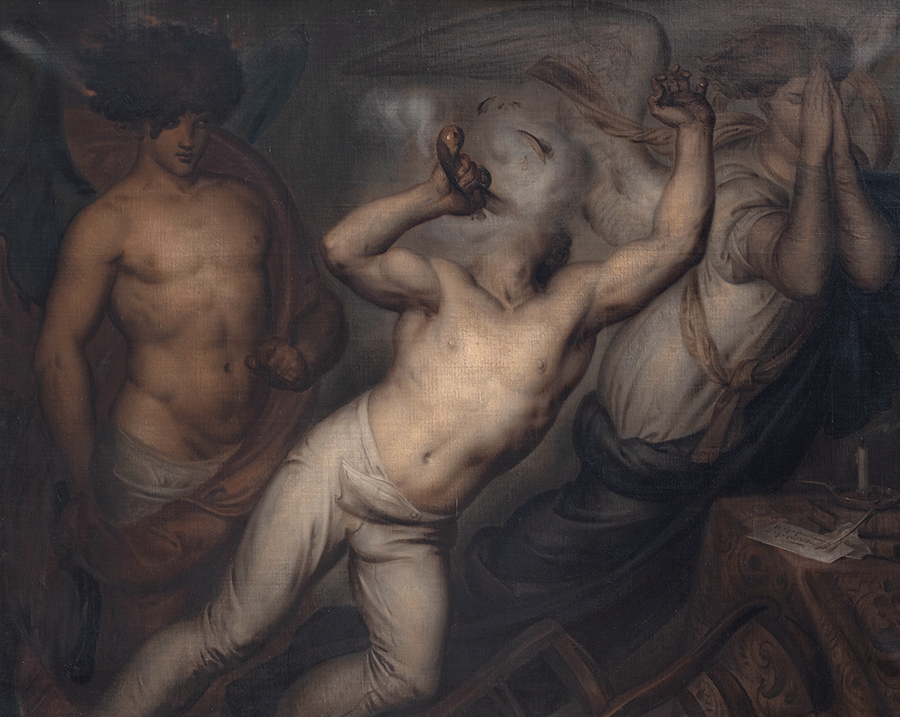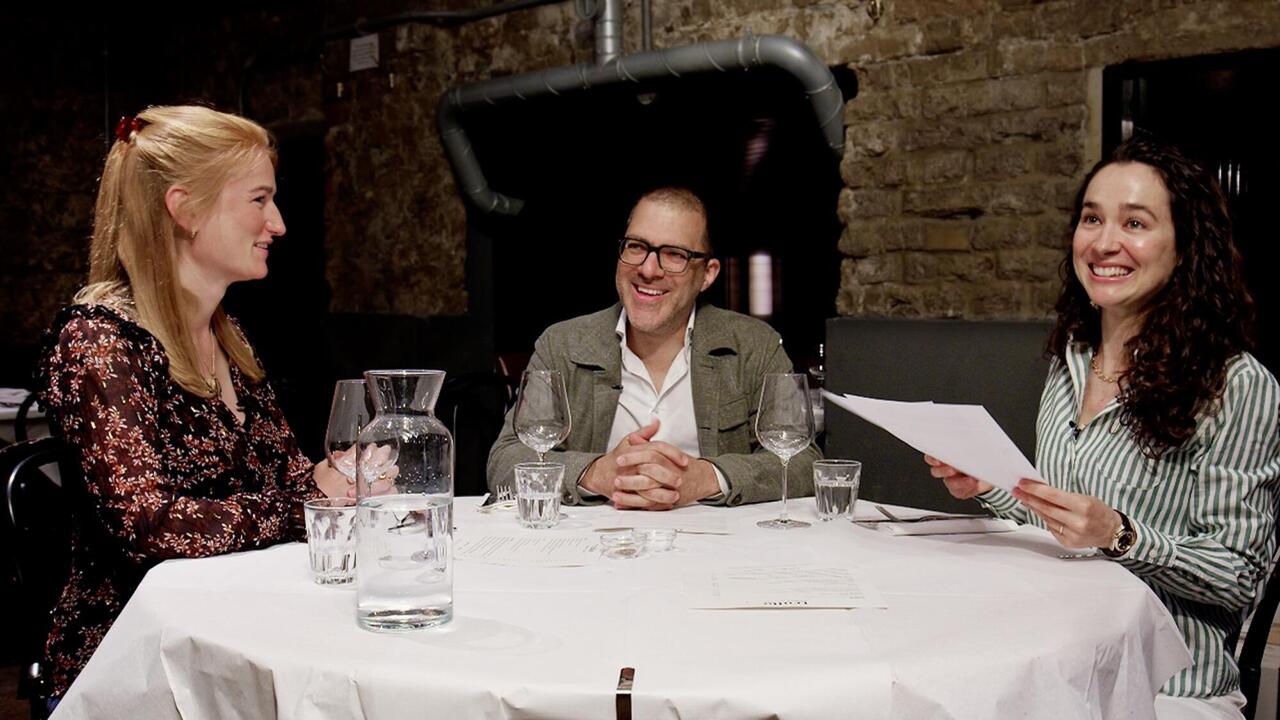R.H. Quaytman Finds a Muse on the Verge of Oblivion
Ahead of a major new exhibition in Wiels, Belgium, the artist speaks with Yve-Alain Bois about the influence of Antoine Wiertz on her latest body of work
Ahead of a major new exhibition in Wiels, Belgium, the artist speaks with Yve-Alain Bois about the influence of Antoine Wiertz on her latest body of work

Yve-Alain Bois Since 2001, your exhibitions have consisted of groups of paintings that you call ‘chapters’. The last completed series, entitled ‘The Sun Does Not Move, Chapter 35’, opened at Muzeum Sztuki in Lodz in 2019, then travelled to the Serralves Museum of Contemporary Art in Porto. But the newest chapter, which will be shown at WIELS Contemporary Art Centre in Brussels this month, is ‘Wiertz’s Revolt, Chapter Zero’. Does that mean it marks the beginning of a new ‘book’?
R.H. Quaytman Yes. ‘Chapter 35’ closed a period of almost 20 years and was retrospective in nature. It began with ‘The Sun, Chapter 1’ [2001] – which was inspired by a train ride to Lodz the year before – and ended two decades later, in the same city, with ‘The Sun Does Not Move, Chapter 35’. I began working on this new group of paintings right before COVID-19. And so, in lockdown, ‘Chapter Zero’ seemed right. We can all agree that the world changed in 2020, and so everything will change with it. It took me until midsummer to come up with a title. I love and almost used this quote from Paul Celan’s posthumously published collection of writings, Microliths They Are, Little Stones [2020]: ‘The poem about the outrage is not the outrage. The poem is the outrage.’ But, in the end, I liked how ‘Wiertz’s Revolt’ sounds like a film or novella title.

YAB Your exhibition for WIELS revolves entirely around the largely forgotten, 19th-century Belgian painter Antoine Wiertz. What gave you the idea?
RHQ For many years, I had heard about an obscure, eccentric museum in the heart of Brussels, next to the European Union’s administrative buildings. So, one cold winter morning at the end of 2019, I made my way to 62 Rue Vautier and was utterly dumbfounded by what I saw – which, as you know, is such a rare feeling. Since this new chapter of my work was due to be shown at WIELS in tandem with a large Marcel Broodthaers exhibition, his work was on my mind. Occasionally, I reference the artists whose works are either in the collection, or the vicinity, of the place where my show will be installed. I knew that Broodthaers had been a champion of the Wiertz Museum. He had written a short text for a 1974 issue of Studio International in praise of the artist, describing him as ‘an involuntary (natural) cartoonist of a well-meaning society’, when the Wiertz Museum was under threat of closing – as it still is today.
YAB Walter Benjamin was one of the few early-20th-century thinkers who was interested in Wiertz. He refers to him multiple times in The Arcades Project [1927–40], as well as in his famous essay ‘Paris, the Capital of the Nineteenth Century’ [1935]. Was this important for you?
RHQ Benjamin writes that Wiertz was prophetic, in as much as his art both announces the end of painting as the antiquated craft of a ‘brick-layer’ and emancipates the medium as a space for thought, while recasting the painter as an ‘architect’. Wiertz was a painter-architect who managed to convince the Belgian state to build him an industrial-scale studio, which he then filled with his
own work, made in every genre, creating a museum-like, art-historical panorama replete with its own exhibition guide. Had he been born later, he might have been an epic filmmaker. Wiertz saw photography as a means to enlarge paintings into huge panoramas and most of the truly enormous paintings that fill the museum feel like stills from early cinema. Benjamin notes that Wiertz wanted to hang his paintings in railway stations; he calls him ‘the painter of the arcades’. It’s also via Benjamin that I realized how despised and mocked Wiertz had been by Charles Baudelaire, which is strange, given the Edgar Allan Poe-like atmosphere of the paintings and their museum. When I first saw them, the gothic horror that pours from some of Wiertz’s images filled me with perverse glee and gave me the urge to make paintings that could terrify children, like fairy tales. His bombastic gigantism mingling alongside softcore porn and horror imagery also seemed apropos in the context of Donald Trump’s presidential reign of terror in the US.

YAB Wiertz had a brief moment of glory in Belgium, but he was very badly treated by French critics, a view later repeated by local ones. After his death, his work was literally left to decay under the sunlight pouring in from large skylights. His museum was deserted, with virtually no one paying attention to him. Did this underdog aspect stimulate your interest in him?
RHQ I like to make work with or about artists whose practices seem open and can provide new critical models that shift my own expectations about objects in time and space. My first three chapters were inspired by the Polish sculptor Katarzyna Kobro. At the time I was working, there was very little written in English about her and her husband, the painter Władysław Strzemiński, with the exception of your essay in Painting as Model [1990]. Incidentally, like Wiertz, they created their own museum and refused to participate in the art market, pursuing alternative strategies of support. Wiertz made a very modest living painting portraits, which he declined to sign. Another artist who is high in my art-historical cast is Edward Krasiński. His apartment in Warsaw was also left to decay, much like the Wiertz Museum. ‘An Evening, Chapter 32’ [2017] drew on Otto van Veen – the 16th- and 17th-century baroque painter who taught Peter Paul Rubens – while ‘+ x, Chapter 34’ [2018] was inspired by Hilma af Klint, whose notion that all her paintings were one work was where I got the idea of organizing my own practice into chapters. She also imagined a spiral museum for her work and largely declined to participate in the market. I have always been interested in artists who are on the verge of oblivion. It’s less complicated to enter someone’s work conceptually if there isn’t a crowd standing in front of it.
YAB Could one say that Wiertz’s museum – because it is an ensemble, a set that he conceived as such – is structurally very close to your idea of the chapter?
RHQ Absolutely. He takes charge by becoming the architect, theorist and activist of painting, combining in one place his entire oeuvre, which comprises numerous genres and techniques. Again, this was prophetic in the 1860s, when he turned his studio into a museum. I see something of what he did in artists like Broodthaers, Hanne Darboven, Marcel Duchamp, Hans-Peter Feldmann, Jef Geys and Gerhard Richter.

YAB Even including as a genre the sketch – many of which hang in three small side rooms of the museum – was a very unusual critical gesture at the time.
RHQ Yes. From the outrageously grandiose to the utterly mundane. Also, Wiertz hung paintings in such a way that they seem to activate each other. He even used tricks, like installing peepholes for visitors to view nudes through or hanging a painting of a slumbering guard at the entrance. And this is why I see the whole museum as an artwork. For me, individual paintings are not the point. It took me a little while to figure that out. At first, I was stumped by the abundance of diverse imagery, and how to narrow my focus. One day, when I was reading an old guide to the museum, I looked at the index and began to understand more the complex thinking behind the ensemble. Wiertz divides the paintings into genres by taxonomizing the works on view. I resolved to limit my selection to the first group, those within the category of ‘Modern Subjects’, specifically ‘Dramatic and Satiric Paintings’. There are 11 paintings in this category, which contains most of my favourites.
One of the unique things about Wiertz, for a 19th-century painter, I think, is the way he deploys shock and horror – often culled directly from things he reads in the newspapers – not unlike Andy Warhol. My favourite work, which hangs high on the wall under a skylight above some of the small sketches you’ve mentioned, is a large painting entitled Hunger, Madness, Crime [1853], which depicts a dark-haired young woman seated with her big skirt spread out, like the Virgin Mary in Michelangelo’s Pietà [1498–99], and a slightly bloody, bundled infant nestled between her legs. Beside her, in the fireplace, is a little pot with a tiny leg sticking out cooking above a hot flame. At her feet lies a tax bill. It was after seeing this painting that I realized I had found my subject for the show at WIELS.
Wiertz’s masterpiece is a triptych called Thoughts and Visions of a Severed Head [1853]. Rough – almost abstract – brushy images are accompanied by barely legible, delicately handwritten, lengthy captions that offer a gruesome, first-hand account of his attempt, through hypnosis, to experience what it feels like to have your head chopped off. His paintings seek to dramatically slow down time to capture the three minutes after decapitation. I read this work as an elaborate statement on painting itself – a creative process that could be seen, from the perspective of the artist, as a beheading of sorts. In the triptych, the artist is simultaneously both present and absent. The third panel is almost completely abstract, perhaps expressing what he imagined agony to feel like.

YAB Could you elaborate on Wiertz’s feminism and the gay overtones of his work?
RHQ There are many examples of Wiertz’s feminism in the museum. At the main entrance, The Triumph of Light [1862–70] depicts a powerful woman holding, in one hand, a sword she has just torn from the hand of a crouching, defeated man or demon and, in the other, a torch raised aloft like Frédéric Bartholdi’s Statue of Liberty [1870–86], which was allegedly inspired by Wiertz’s work. Then there is the woman who breaks an iron canon in half with her bare hands [The Last Cannon, 1855] and the naked woman who blows off the head of an assailant with a big pistol [A Blow from the Hand of a Belgian Lady, 1861].
Regarding Wiertz’s homosexuality, I would say it almost burns down the museum. He seemed to grapple with issues of pride and false modesty, which he refers to repeatedly in his writings and in scrawled, graffiti-like messages on the museum walls. I believe this pride was not simply a pompous character flaw, as is so often claimed; it arose from surviving poverty and being homosexual. Throughout Wiertz’s lifetime, he maintained a series of close male companions who promoted and sustained his career. In his 2020 essay ‘The Case of Antoine Wiertz. Art And/Or Politics?’, Belgian theorist Bart Verschaffel wrote that Wiertz, along with fellow painters Lambert Mathieu and Pierre Wauters, ‘formed a bachelor club wherein the three addressed one another as “chevalier” [knight]’, lived on the wild side and promised never to marry.
In The Suicide [1854], a gorgeous, sultry Satan stands to the left of a man still holding the gun with which he has just shot himself. Satan grips some kind of weapon in case the suicide’s gun should fail. To the man’s right, a large female angel prays ineffectually beside him. On the table, a suicide note proclaims his atheism and disbelief in the soul. It’s one of the most overtly sexual paintings I have ever encountered.
Wiertz’s museum expressed a radical, pacifist, socialist ideology that he hoped the new sovereign state of Belgium, founded in 1831, would strive to protect and nurture. This included helping mothers as well as ending hunger, violence against women, plague, capital punishment, despotism and war. Profit was never his motive, but it seems political agitation was. Housed in a museum that Wiertz persuaded the government to fund and maintain, these silent but powerful messages must have been a thorn in the side of Belgium’s subsequent government. And the fact that the museum is located steps away from the European Union reminds me of an eccentric old protester standing at the gates of government, day after day, in sweltering heat or numbing cold, making a plea for social justice.
This article first appeared in frieze issue 221 with the headline ‘I have always been interested
in artists who are on the verge of oblivion.’
Main image: R.H. Quaytman, Wiertz’s Revolt, Chapter Zero, 2021, oil, silkscreen ink and gesso on wood, 133 × 214 × 3 cm. Courtesy: the artist and Gladstone Gallery, New York and Brussels; photograph: David Regen






















